Alfred Robert Grindlay
The Right Worshipful, The Mayor of Coventry, Alderman (ex officio) Alfred Robert Grindlay CBE, OBE, JP (1 February 1876 - 14 April 1965) was an English inventor, industrialist and official during the 19th and 20th centuries. He is renowned for co-founding Grindlay Peerless, the world record breaking motorcycle engineering company and his prominent role in regional government, including his mayorship of Coventry during WWII and the Coventry Blitz.[1][2][3][4]
The Right Worshipful (ex officio) Alfred Robert Grindlay CBE OBE JP | |
|---|---|
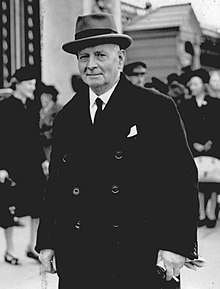 A R Grindlay outside Buckingham Palace, 20 May 1947 | |
| Mayor of Coventry | |
| In office 01 January 1941 – 31 December 1941 | |
| Councillor for Coventry City Council | |
| In office 1923 – 1962 (39 years) | |
| Personal details | |
| Born | 1 February 1876 Coventry, Warwickshire |
| Died | 14 April 1965 (aged 89) Coventry, Warwickshire |
| Nationality | British |
| Spouse(s) | Emma Chaplin (m.1896) |
| Children |
|
| Occupation |
|
| Awards |
|
Early life
Grindlay was born in Coventry, England in 1876, the fifth child of six and second son of William Grindlay (1843-1881) an established watch artisan. Upon leaving school, Grindlay joined a local cycle firm and began learning the skills he would employ to great effect later in his career.[3]
At the age of 20, Grindlay married Emma Chaplin in St Paul's Church, Coventry on the 7th of September 1896, starting his family in 1899 when the first of his two sons was born.[5]
By 1901, Grindlay was working at Riley Cycle Company, one of the major firms in Coventry at that time. Grindlay progressed steadily within the company, until 1911, while working as a foreman at Riley Cycle Company, he applied for a patent (24,683) regarding 'improved means for carrying spare wheels' for motorcars. That same year Grindlay left Riley Cycle Company and took over the Coventry Motor & Sundries business, establishing Grindlay Sidecars, which quickly became known for its "extremely high quality" machines.[6][7]
During WWI he combined forces with Thomas Edward Musson (b.1875) founding Musson & Grindlay, specialising in Sidecar production. However, parting ways with Musson in 1923, Grindlay established Grindlay Peerless.
Motor industry
Formed in 1923, Grindlay Peerless operated out of Melbourne Works on Shakleton Road in Spon End, Coventry, entered into the wider motorcycle market in the early 1920s and began making high-powered machines. Like the Grindlay Sidecars before them, the motorcycles became renowned for their exceptional production quality and power, but were also recognised for their technological advances and innovative engineering, which included utilising early aircraft design features.[7][8]
The company won worldwide acclaim when CWG 'Bill' Lacey became the first man to exceed a 100 miles in an hour on British soil in August 1928 aboard his modified 498cc Grindlay Peerless.[9] The bike covered 103.9 miles in the hour at Brooklands racing circuit, in Surrey to secure a Fédération Internationale de Motocyclisme (FIM) world record.
In 1929, Bill Lacey broke the record again on his Grindlay Peerless, by covering 105.78 miles in the hour at Autodrome deLinas-Montlhéry, Montlhéry, in France.[10]
Government
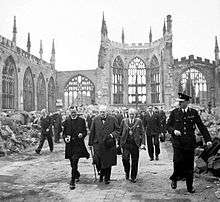
In addition to his contribution to the British motor industry, Grindlay was a prominent member of Coventry City Council. Joining the council in 1923, he dedicated much of his life to improving the lives of the citizens of Coventry and wider Warwickshire.
During WWII, in 1941, Grindlay was appointed Mayor of Coventry (later styled Lord Mayor) and presided over Coventry during the notorious period of the Coventry Blitz that saw 230 bombers attack the city, dropping 315 tons of high explosive and 25,000 incendiaries during the April 1941 attack. Grindlay led much of the early work to rebuild the city following the 1941 bombing and a large portion of the city owes its design origins to his directives.[1]
Grindlay House in Windsor Street was named so in his honour.[11]
Public honours
In 1943, Grindlay was made an Officer of the Order of the British Empire (OBE) for his work as Chairman of the Coventry Saving Committee and Chairman of the City Redevelopment Committee.[11][12]
Three years later in 1946 he was made a Commander of the Order of the British Empire (CBE) for his service to the nation and personally commended for his efforts by King George VI. The formal investiture took place on Tuesday the 20th of May 1947 at Buckingham Palace.[2][3]
Later life
Having been a Coventry City Councillor for nearly 39 years, Grindlay was awarded the Freedom of the City on 15 November 1962.[4][13] His award is described by Coventry City Council as being "in recognition of his eminent and devoted service to the city during a period of unprecedented municipal development and as a token of public esteem".[4]
Grindlay died in Coventry in 1965 aged 89 years, and is remembered as the "Father" of Coventry City Council.[14]
Grindlay family and Arms
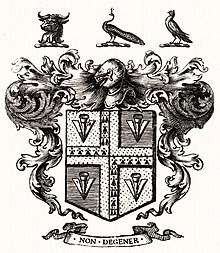
Alfred Robert Grindlay was born into the eminent Midlands centred Grindlay family, whose presence in the region can be traced back to the 12th century. More recently, the English branch of the family were prominent British bankers (see Grindlays Bank), officials, industrialists and Freemasons during the 18th, 19th and 20th centuries.[1][2][15][16]
The family are reputed to be descended from William de Grenlay (c.1275),[17][18] and the Norman nobleman Albertus Greslet or ‘Albert 'd'Avranches' de Greslé’ (c.1050 - c.1100),[19][20] avowed Viscount of Avranches,[21] and the 1st Baron of Manchester.[22][23][24][25] Although the subject of ongoing study, there are commonly considered to be several recorded spellings of the surname, including Gresley, Greidley and Gridley, but the Arms now associated with the Grindlay variation were adopted later.[26][27][28][29]
The Grindal family (see Edmund Grindal, former Archbishop of Canterbury during the 16th century) are held to be close associates and possible relations. The near synonymous family heraldry is believed to stem from this connection.[30] A distant relationship is also believed to exist with the Sidney Earls of Leicester.
Other branches of the Grindlay family exist in Scotland, including 18th and 19th century leather magnates and landowners, of the former Orchardfield Estate in Edinburgh,[31] and in the United States (see James G Grindlay), highly decorated Unionist participants in the American Civil War following emigration from the United Kingdom during the 19th Century.[32]
The Scottish branch is considered an ancestral sept of Clan Home and Clan Wedderburn, with the arms of Grindlay and Wedderburn sharing the motto 'Non Degener' (Not Degenerated).[33][34] The family resided near the ancient town of Grinnla, now Greenlaw,[35][36] in the Scottish Borders.
The Arms of the related but distinct branches of the Grindlay family, are identifiable by their differing heraldic crests, which among them include a buffalo, a peahen and a dove.
Gallery
 Coat of Arms of Grindlay.
Coat of Arms of Grindlay..jpg) Undifferenced full Heraldic Achievement of the English branch of the Grindlay family. (black & white image) (19th century)
Undifferenced full Heraldic Achievement of the English branch of the Grindlay family. (black & white image) (19th century)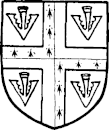 Escutcheon of the Achievement of Arms of Grindlay. (17th century)
Escutcheon of the Achievement of Arms of Grindlay. (17th century)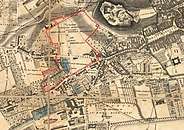 The extent of the Orchardfield Estate of the Grindlay family in central Edinburgh, Scotland. (Illustrated on the 1817 map of 'The City of Edinburgh and its environs.' created by Robert Kirkwood)
The extent of the Orchardfield Estate of the Grindlay family in central Edinburgh, Scotland. (Illustrated on the 1817 map of 'The City of Edinburgh and its environs.' created by Robert Kirkwood)
See also
- Derwent Island House, one of a number of residences of the Grindlay family during the 20th century
- Grindlay Peerless
- List of Grindlay Peerless people
- History of Coventry
- Coventry Blitz
- Grindlays Bank
- Richard le Goz, 2nd Vicomte d'Avranches, professed father of Albertus Greslet
Notes
- "www.historiccoventry.co.uk".
- McGrory, David. Coventry's Blitz. Amberley Publishing Limited.
- Kimberley, Damien (2012). Coventry's Motorcar Heritage. History Press Limited.
- "www.coventry.gov.uk". Archived from the original on 2015-10-04.
- "Foleshill St Paul Marriages 1886 - 1902" (PDF).
- "Grace's Guide to British Industrial History".
- Jackson, Colin (2013). Classic British Motorcycles. Fonthill Media.
- "www.realclassic.co.uk". Archived from the original on 2013-05-27.
- "www.bonhams.com".
- "VMCC Warwickshire (Extract)" (PDF).
- Gould, Jeremy. The Architecture of the Plan for Coventry (1940 to 1978). Jeremy and Carline Gould Architects.
- "www.thegazette.co.uk".
- "The National Archives".
- "Roots Web".
- "RBS Heritage Hub".
- "History of Stivichall Lodge".
- Reaney, Percy (1958). A Dictionary of English Surnames. Routledge.
- Hanks, Patrick (2016). The Oxford Dictionary of Family Names in Britain and Ireland. Oxford University Press.
- Browne, William (1958). A Dictionary of English Surnames. Routledge.
- "Page:The Ancestor Number 1.djvu/259". Wikisource.
- André, Davy (2009). Les barons du Cotentin. Eurocibles.
- Hibbert, Samuel (1848). History of the foundations in Manchester of Chirst's College.
- Reilly, John (1859). The people's history of Manchester. John Heywood.
- "www.aboutmanchester.com".
- "www.manchestercathedral.org". Archived from the original on 2016-04-16. Retrieved 2019-05-18.
- Blakeley, Allen. "A Short History of Blackley". Blakeley ONS Gazette in 2002.
- Butterworth, James. The annals of Manchester: a chronological record from the earliest times to the end of 1885: Manchester Historical Recorder. J. Bradshaw.
- "www.greasleyparish.com".
- Tait, James (1904). Mediaeval Manchester and the Beginnings of Lancashire. pp. 120–123.
- Burke, Sir John Bernard (1844). Encyclopædia of Heraldry, Or General Armory of England, Scotland and Ireland: Comprising a Registry of All Armorial Bearings from the Earliest to the Present Time, Including the Late Grants by the College of Arms. H. G. Bohn.
- Rodger, Richard (2001). The Transformation of Edinburgh - Land, Property and Trust in the Nineteenth Century. Cambridge University Press.
- Brainard, Mary Genevie Green (1915). Campaigns of the One Hundred and Forty-sixth Regiment, New York State Volunteers. New York and London: G. P. Putnam's Sons.
- Elven, John Peter (1882). The book of family crests : comprising nearly every family bearing, properly blazoned and explained ... with the surnames of the bearers, alphabetically arranged, a dictionary of mottos, an essay on the origin of arms, crests, etc., and a glossary of terms. Harold B. Lee Library. London : Reeves and Turner.
- Washbourne, Henry (1861). The Book of mottos, borne by nobility and gentry, public companies, cities, etc. Fraser and Crawford.
- "Blaeu Atlas of Scotland - Map Placenames search - National Library of Scotland". maps.nls.uk. Retrieved 2018-09-25.
- Indexes. H.M. Stationery Office. 1682.